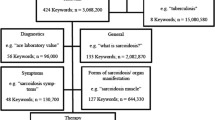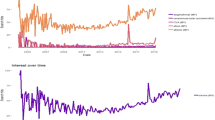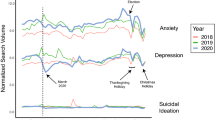Abstract
Several conventional cross-sectional studies have investigated the impact of the coronavirus disease (COVID-19) pandemic on patients with axial spondyloarthritis (axSpA) and reached contrary results regarding health and well-being. As analysis of web search data already provided insights into public interest and unmet needs, this study aimed to examine axSpA-related web searches before and during COVID-19 pandemic to gain a different perspective on the impact of COVID-19 on this disease. The Google Ads Keyword Planner was used to generate axSpA-related keywords and their monthly number of searches between June 2018 and November 2021 in Germany. These keywords were qualitatively classified into seven categories. A total of 538 axSpA-related keywords were used for the analysis. The number of axSpA-related searches increased during COVID-19 pandemic (before: n = 1,525,010 vs. during: n = 1,848,300), particularly searches for symptoms, disease outcomes, and causes, while interest in disease management and diagnosis decreased. This study demonstrated a shift in public interest in axSpA during COVID-19 in Germany and highlights an urgent expansion of telemedicine to be prepared for exceptional situations such as a pandemic.
Similar content being viewed by others
Introduction
Axial spondyloarthritis (axSpA) is a chronic inflammatory disease that primarily affects the sacroiliac joints and the spine with inflammatory back pain, but can also include extra-articular manifestations like arthritis, enthesitis, psoriasis, iritis, and inflammatory bowel disease1. In March 2020, the World Health Organization declared a global pandemic caused by coronavirus disease (COVID-19)2, initiating a period of restrictions and multiple lockdowns, which could lead to new diseases or exacerbation of pre-existing diseases by reducing healthcare provider consultations and/or affecting mental health3,4. Ciuera et al. found no evidence of worsening disease activity in axSpA during the lockdown5, while others demonstrated that approximately 50% of axSpA patients reported worse health status and well-being than before the pandemic6,7. As analysing web search data on health topics can contribute to a better understanding of the interest and needs on a population-level8,9, this study aimed to examine the impact of the COVID-19 pandemic on axSpA in Germany by comparing axSpA-related web searches before and during the COVID-19 pandemic (cut-off: March 2020) in terms of search content.
Methods
In this retrospective analysis, the Google Ads Keyword Planner was used. Originally designed for marketing campaigns, its capability to provide monthly search volume data (i.e., monthly number of web searches)8,10. To ascertain the search volume in a specific area, search terms are input into the planner, language and geographical settings are set, and the program subsequently generates the most relevant keywords and phrases for the topic. For this study, six German search terms were entered to obtain related keywords and phrases with their monthly search volume between June 2018 and May 2022 in Germany (Fig. 1). The n = 543 identified keywords were individually checked for their relevance to axSpA, leading to the exclusion of five keywords which were unspecific and not clearly axSpA-associated (e.g., “back pain due to bacteria”, “inflamed back muscle“). The time period was shortened by 6 months to ensure an equal number of months before and during COVID-19. The remaining keywords were inductively categorised into seven categories based on the study by Berr et al.8: (1) terms and definition (e.g., “spondyloarthritis”, “rheumatism Morbus Bechterew”), (2) disease outcomes (e.g., “life expectancy”, “rheumatism back pain”), (3) disease management (e.g., “treatment”, “experience reports”), (4) diagnosis (e.g., “Bechterew diagnosis”, “HLA B27”), (5) symptoms (e.g., “rheumatism back symptoms”), (6) causes (e.g., “Morbus Bechterew causes”), and (7) COVID-19 vaccines. For recurring topics, categories were further classified into subcategories (e.g., physical manifestations). Each keyword was assigned to one (sub-)category only. Data was analysed descriptively.
Ethical approval
Institutional review board approval and informed consent were not necessary, because the study used publicly available data.
Results
Overall, 538 keywords with n = 3,373,310 axSpA-related searches were identified for Germany between June 2018 and November 2021 using Google Ads Keyword Planner (Fig. 1). Although axSpA-related searches were at a low level at the beginning of the COVID-19 pandemic (Fig. 2), searches increased during the COVID-19 pandemic (before: n = 1,525,010 vs. during: n = 1,848,300). For both periods, “Morbus Bechterew” (German synonym for axSpA) was most frequently searched and about three-quarters of all searches were related to terms and definitions, which was in line with previous findings8. During COVID-19, axSpA searches related to symptoms (4.9% vs. 6.7%), disease outcomes (9.1% vs. 10.6%), and causes (0.3% vs. 0.5%) slightly increased, whereas searches decreased for disease management (4.2% vs. 3.5%) and diagnosis (2.9% vs. 2.7%, Fig. 1). Searches on disease outcomes shifted from prognostic outcomes (54.8% vs. 46.0%) to physical manifestations (45.2% vs. 54.0%), with higher interest in comorbidities and extra-articular involvement (35.4% vs. 53.0%) than in axial involvement (47.6% vs. 37.2%, Figs. 1, 3). Searches on axSpA prognostic outcomes, particularly life expectancy, decreased during COVID-19 (50.2% vs. 35.7%), while searches for end stages of axSpA (18.3% vs. 22.8%), course of disease (13.1% vs. 19.9%), and work disability (4.8% vs. 9.1%) increased. Among disease management of axSpA, searches slightly differed between before and during COVID-19: searches related to treatment (70.4% vs. 68.8%) decreased and searches related to lifestyle (10.3% vs. 10.4%) and peer support slightly increased during COVID-19 (19.3% vs. 20.8%, Fig. 1).
Physical manifestations in axSpA-related web searches. Percentage of axSpA-related web searches on subcategory physical manifestations of axSpA in Germany before (06/2018–02/2020) and during COVID-19 pandemic (03/2020–11/2021). (a) Including non-localisable and general searches for comorbidities (before COVID-19: 15.8%, during COVID-19: 29.8%; e.g., “comorbidities morbus bechterew” or “weight loss morbus bechterew”). (b) E.g., “morbus bechterew pain”. The contour of the female body was obtained from the R package “gganatogram” developed by Maag JLV (2018): doi: https://doi.org/10.12688/f1000research.16409.2. axSpA, axial spondyloarthritis; COVID-19, coronavirus disease.
Discussion
In summary, the initial decrease in axSpA-related searches during the pandemic could be explained by the widespread attention regarding COVID-1910. However, overall axSpA-related searches increased during COVID-19, particularly for symptoms and physical manifestations, in addition to unknown factors not attributable to the pandemic, possibly due to the lack of medical appointments to clarify symptoms, provide medical information, and support for those affected. A reduction of consultations in German primary care during COVID-19 was previously found, mainly concerning manifestations of axSpA like back pain, gastrointestinal symptoms, fatigue, and pain therapy1,3, which may have led to the exacerbation of axSpA7. The higher interest in poor disease outcomes, like end stage and work disability, and in peer support may reflect general mental health impairments during lockdowns in the German population4, warranting further exploration. Additionally, the observed emphasis on these aspects may be attributed to the lack of information and comfort during restrictions resulting from the absence of in-person rheumatology appointments, which were rated as very important by the majority of axSpA patients surveyed in the United Kingdom7. Despite limitations, including the focus on Google users, exclusion of non-German speakers and potentially elderly, the impact of autocomplete, and reliance on monthly estimations, the study highlights the change in unmet needs. This emphasizes the urgency need to expand telemedicine concepts and increase patient confidence in them, to provide healthcare in exceptional situations, like a global pandemic.
Data availability
The datasets generated during and/or analysed during the current study are available from the corresponding author on reasonable request.
References
Sieper, J. & Poddubnyy, D. Axial spondyloarthritis. Lancet 390, 73–84. https://doi.org/10.1016/S0140-6736(16)31591-4 (2017).
Cucinotta, D. & Vanelli, M. WHO Declares COVID-19 a pandemic. Acta Biomed. 91, 157–160. https://doi.org/10.23750/abm.v91i1.9397 (2020).
Schäfer, I. et al. The effect of COVID-19 pandemic and lockdown on consultation numbers, consultation reasons and performed services in primary care: Results of a longitudinal observational study. BMC Fam. Pract. 22, 125. https://doi.org/10.1186/s12875-021-01471-3 (2021).
Benke, C. et al. Lockdown, quarantine measures, and social distancing: Associations with depression, anxiety and distress at the beginning of the COVID-19 pandemic among adults from Germany. Psychiatry Res. 293, 113462. https://doi.org/10.1016/j.psychres.2020.113462 (2020).
Ciurea, A. et al. Impact of the COVID-19 pandemic on the disease course of patients with inflammatory rheumatic diseases: Results from the Swiss Clinical Quality Management cohort. Ann. Rheum. Dis. 80, 238–241. https://doi.org/10.1136/annrheumdis-2020-218705 (2021).
Benavent, D. et al. Poor health and functioning in patients with axial spondyloarthritis during the COVID-19 pandemic and lockdown: REUMAVID study (phase 1). Ther. Adv. Musculoskelet. Dis. 14, 1759720X211066685. https://doi.org/10.1177/1759720X211066685 (2022).
Marzo-Ortega, H. et al. COVID-19 in axial spondyloarthritis care provision: Helping to straighten the long and winding road. Lancet Rheumatol. 3, e11–e13. https://doi.org/10.1016/S2665-9913(20)30413-6 (2021).
Berr, K. et al. Analyzing web searches for axial spondyloarthritis in Germany: A novel approach to exploring interests and unmet needs. Rheumatol. Int. https://doi.org/10.1007/s00296-023-05273-x (2023).
Mei, Y.-J. et al. Using internet search data to explore the global public concerns in ankylosing spondylitis. Postgrad. Med. J. 97, 93–96. https://doi.org/10.1136/postgradmedj-2019-137407 (2021).
Schuster, B. et al. Retracing the COVID-19 Pandemic in Germany from a Public Perspective using Google Search Queries Related to “coronavirus” (Retracing the COVID-19 Pandemic in Germany from a Public Perspective using Google Search Queries Related to “coronavirus”). Gesundheitswesen 83, e9–e14. https://doi.org/10.1055/a-1398-5417 (2021).
Acknowledgements
The authors would like to thank Linda Tizek for her support.
Funding
Open Access funding enabled and organized by Projekt DEAL.
Author information
Authors and Affiliations
Contributions
S.Z., M.W., and A.Z. contributed to the study conception and design. H.W. analysed, interpreted, and wrote the first draft of the manuscript. S.Z., M.H., M.W., and A.Z. revised the manuscript substantially. All authors have approved the final article.
Corresponding author
Ethics declarations
Competing interests
Parts of this study were financially supported by an unrestricted research grant from Novartis Pharma GmbH. HW, SZ, MH, and AZ declare that they have no conflict of interest. MW reports consulting, lectures, presentations, speakers’ honoraria, manuscript writing, educational events or support for attending meetings and/or travel from Novartis, Abbvie, and UCB.
Additional information
Publisher's note
Springer Nature remains neutral with regard to jurisdictional claims in published maps and institutional affiliations.
Rights and permissions
Open Access This article is licensed under a Creative Commons Attribution 4.0 International License, which permits use, sharing, adaptation, distribution and reproduction in any medium or format, as long as you give appropriate credit to the original author(s) and the source, provide a link to the Creative Commons licence, and indicate if changes were made. The images or other third party material in this article are included in the article's Creative Commons licence, unless indicated otherwise in a credit line to the material. If material is not included in the article's Creative Commons licence and your intended use is not permitted by statutory regulation or exceeds the permitted use, you will need to obtain permission directly from the copyright holder. To view a copy of this licence, visit http://creativecommons.org/licenses/by/4.0/.
About this article
Cite this article
Wecker, H., Ziehfreund, S., Hindelang, M. et al. Change of perspective: impact of COVID-19 pandemic on axial spondyloarthritis-related web searches in Germany. Sci Rep 14, 4044 (2024). https://doi.org/10.1038/s41598-024-54047-3
Received:
Accepted:
Published:
DOI: https://doi.org/10.1038/s41598-024-54047-3
Comments
By submitting a comment you agree to abide by our Terms and Community Guidelines. If you find something abusive or that does not comply with our terms or guidelines please flag it as inappropriate.






